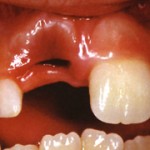Before I explain to you regarding the emergency measures that you should perform when your child knocks his tooth out, let me briefly discuss about what will happen to a tooth after it is completely displaced out of socket. Success of a replantation depends on the amount of time the tooth is out of socket and storage medium used to store the avulsed tooth. Avulsion is complete displacement of tooth out of socket.
Avulsion of primary teeth and sequelae to its permanent successor
-Â Â Â Â Â Â Â Â Â Â infection, abscess, loss of space in dental arch which requires orthodontic treatment in the future, ankylosis, failure of the particular tooth to erupt normally, color changes, injury to permanent tooth and etc
Sequelae to its permanent successor: Pulp of the permanent successor can undergo necrosis, inflammation and resorption.
Emergency measures when your child knocks his tooth out
- First of all, try to calm yourself down.
- Â Reassure your child that everything will be alright.
- Contact a nearby dentist and report emergency situation. Allow him to guide you step by step on how to replant the tooth into the socket.
- Assuming that there is no unfavorable medical history, you should replant the tooth into the socket because the prognosis is most favorable if the tooth is replanted within half an hour.
- Locate the missing tooth and hold the tooth by its crown. (not by its root)
- Rinse the tooth under cold water for few seconds or dab the tooth gently with a wet napkin to remove foreign particles or dirt.
- Replant the avulsed tooth carefully into its socket. Make sure you replant the tooth in the correct direction. (compare with the other side)
- Â Ask your child to keep the tooth in place by biting on a handkerchief.
- After replantation of the avulsed tooth, you should report to a dentist as soon as possible so that further management can take place.Â
If replantation of avulsed tooth is not possible, you must keep the tooth in suitable storage medium while transporting it to the dental clinic. It is important that you choose a suitable storage medium to keep the avulsed tooth in order to maintain the vitality of periodontal tissues attached to the root surface.
Storage medium:
Milk: has been reported to be a satisfactory medium to transport the avulsed tooth.
Water: Water is hypotonic. It can cause lysis of periodontal ligament cells if you store the avulsed tooth in water.
 If milk is not available, you can place the avulsed tooth in a handkerchief moistened with your kid’s saliva.  However, saliva contains bacteria which make it a less suitable storage medium.
Hanks Balanced Salt Solution is the best storage medium for avulsed tooth. It is biocompatible and it can rejuvenate the periodontal ligament cells. Hanks Balanced Salt solution is found in products such as Save a Tooth which is available at many local drug stores.
What will the dentist do?
If the tooth is replanted into the socket, the dentist will check for additional injuries , stability and alignment of the particular tooth.
Your dentist will
- Check whether it is necessary to replant the tooth. Root resorption and failure of replantation can take place if the tooth is not replanted under ideal condition.
- Place the tooth immediately in a cup of sterile saline.
- Take a radiograph of the area of injury.
- Examine the avulsion site for any loose tooth fragments.
- Deposit some local anesthetic solution around the area before replantation of the avulsed tooth.
- Irrigate the socket with saline to remove foreign debris.
- Place the tooth gently into its socket.
- Your child will be asked to bite on a piece of gauze.
- Stabilise the tooth by splinting for 2 weeks.
Medications such as antibiotics will be prescribed because the tooth will certainly have become infected. Â Make sure your child is on a soft diet and keep the area clean by using a soft tooth brush and chlorhexidine mouthwash.
What happens after tooth replantation?
1-2 weeks after replantation:
Your dentist will remove the splint around the avulsed tooth and a radiograph of the tooth will be taken to evaluate any signs of root resorption.
3-4 weeks after replantation: Endodontic treatment can be carried out during this time. Pulpectomy (removal of pulpal tissue) can be carried out on mature , fully developed tooth. Your dentist might need to monitor the immature tooth which is replanted.
3-4 weeks interval:Â Radiograph of the avulsed, immature tooth will be taken again and root canal treatment will be performed if there is any sign of root resorption.
